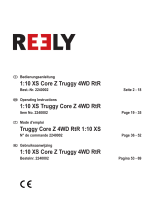
19
Table of contents
Page
1. Introduction ........................................................................................................................................................ 21
2. Explanation of symbols ...................................................................................................................................... 21
3. Intended use ...................................................................................................................................................... 21
4. Delivery content ................................................................................................................................................. 21
5. Spare parts list ................................................................................................................................................... 22
6. Up-to-date operating instructions .......................................................................................................................22
7. Safety instructions .............................................................................................................................................22
a) General ........................................................................................................................................................23
b) Driving the car .............................................................................................................................................23
8. Battery information and safety ........................................................................................................................... 24
a) General information ..................................................................................................................................... 24
b) Li-Ion battery ................................................................................................................................................24
c) AA (rechargeable) batteries .........................................................................................................................25
d) Charging the model battery .........................................................................................................................25
9. Operating elements ...........................................................................................................................................26
a) Model car .....................................................................................................................................................26
b) Transmitter (remote control) ........................................................................................................................27
10. Getting ready for driving ....................................................................................................................................28
a) Charge the car battery .................................................................................................................................28
b) Insert the transmitter batteries .....................................................................................................................28
c) Remove/replace the cover ..........................................................................................................................28
d) Insert car battery ..........................................................................................................................................29
11. Driving ................................................................................................................................................................29
a) Switch the transmitter and receiver ON ....................................................................................................... 29
b) Driving the model .........................................................................................................................................30
c) Adjusting trim/speed/steering inputs ............................................................................................................31
12. Finished driving ..................................................................................................................................................31
13. Tuning ................................................................................................................................................................ 32
14. Troubleshooting .................................................................................................................................................33
15. Care and maintenance ......................................................................................................................................34























